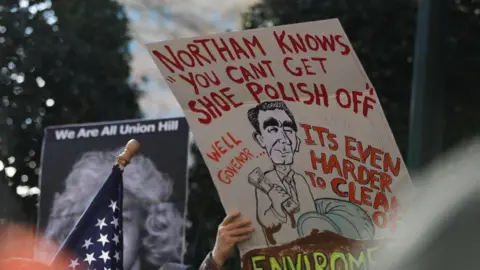How school yearbooks have the power to destroy lives
There are many ways to bring down an opponent, but up until a few months ago, who would have thought a school yearbook would be quite such an effective tool?
But time and time again, old school yearbooks are being dug up and thrown open - revealing treasure troves of comments and pictures the implicated would have preferred remained buried.
Just look at the way the words of Supreme Court Judge Brett Kavanaugh's entry in his 1983 high school yearbook was pored over. Proof, his detractors argued, he was a liar. Proof, therefore, he should not be confirmed to the highest court in the US.
Then there is the picture on Ralph Northam's page in his Eastern Virginia Medical School yearbook. The photo - a man in blackface, and another dressed as the Ku Klux Klan - is proof he is a racist, his detractors argue. Proof he should no longer be governor of Virginia.
In both cases, the men argue, they were misrepresented. Mr Kavanuagh said the words in his yearbook were being misinterpreted, while Gov Northam said it was not him in the offending picture.
Either way, it didn't really matter. School yearbooks, it seemed, are no longer just a fun way of finding out what a film star looked like before they were famous. School yearbooks, it turns out, can destroy lives.
 AFP
AFPIt didn't take long for newspapers and political opponents to start flicking through old yearbooks in search of more scandal after Gov Northam's blackface photograph emerged.
The tradition is more than 200 years old, although the first "official" one - snappily called "Profiles of Part of the Class Graduated at Yale College, September, 1806" - had silhouettes rather than pictures.
According to a 2010 NPR report, by 1995 US colleges were producing some 2,400 yearbooks annually. Add to that the high schools, and the sheer potential for scandalous entries becomes all too clear.
In the last week alone, the Daily Mail has uncovered pictures of people wearing KKK costumes "lynching" a man in blackface in the North Carolina governor's 1979 yearbook - although there is "no suggestion" Roy Cooper appeared in any of the tome's offending images.
The New York Times trawled through more of Eastern Virginia Medical School yearbooks to find a catalogue of sexist and racist incidents. A Guardian report notes editions of Corks and Curls, the University of Virginia's yearbook, at least before the 1970s, were full of more of the same.
But you don't have to be famous to be caught up in the furore over their contents. Those who are identifiable in the various controversial images have found themselves named and shamed in local media.
The lasting impact on their careers, and their reputations, is as yet unclear.
In fact, you don't even have to have left high school to find yourself in serious trouble over your yearbook photograph: look at the case of Hunter Osborn, an Arizona senior who ended up facing 69 counts of indecent exposure back in 2016.
Why? Because he had exposed himself during a team photo for a dare - the same photo which was later included in the high school yearbook.
So, the day the teenager should have been at the prom, he found himself under arrest, wearing an ankle monitor, facing the possibility of a long sentence and having to sign onto the sex offenders register.
The enormity was not lost on his fellow students.
Allow X content?

"It's something that's going to be on his record for the rest of his life," Brooke Bodrero told local television. "The consequences are a little harsh."
Thousands of people agreed: a petition to "free Hunter Osborn" - got almost 7,000 signatures. The petition writer, Alex Labban, put it simply: "Hunter needs to be held accountable for his actions but that doesn't mean ruining his life!"
Prosecutors eventually decided to drop the charges - helped by the fact not one of the 69 "victims" of the alleged crime were actually prepared to press charges.
But could this all soon be a thing of the past? As demand grows for yearbooks in countries like the UK and India, the popularity of school yearbooks declines in the US. According to NPR, only 1,000 yearbooks were published by colleges in 2010. The advent of the internet and social media have no doubt harmed their popularity.
The aforementioned Corks and Curls closed in 2009 because there was "not enough funding or student interest", The Guardian reported.
But then there is also potentially the creeping realisation that much of what has been included over the years is, frankly, concerning.
Five years before Gov Northam's yearbook came to light, his alma mater's current head, Dr Richard Homan ended the practice. He was, he said, concerned about how the 2013 edition - complete with Confederate flags and outfits - would be perceived.
 AFP
AFPBut then again, students today don't need to wait for their school yearbook to be uncovered for their careers and reputations to be damaged. The internet may have removed the need for yearbooks, but it means many of the photographs you may later regret can go viral - instantly.
Take the boys from Baraboo High School in Wisconsin who were pictured apparently making the "Sieg Heil" gesture. The school district later said it could not establish what the boys were truly intending to do, CNN reported.
All the same, people remember that picture - and it could well follow them around, as Stefanie Niles, president of the National Association for College Admission Counseling, noted last year.
"Everything has a reverberating effect," she said. "I think a lot of those young men will have a variety of responses from the institutions that were considering them."
